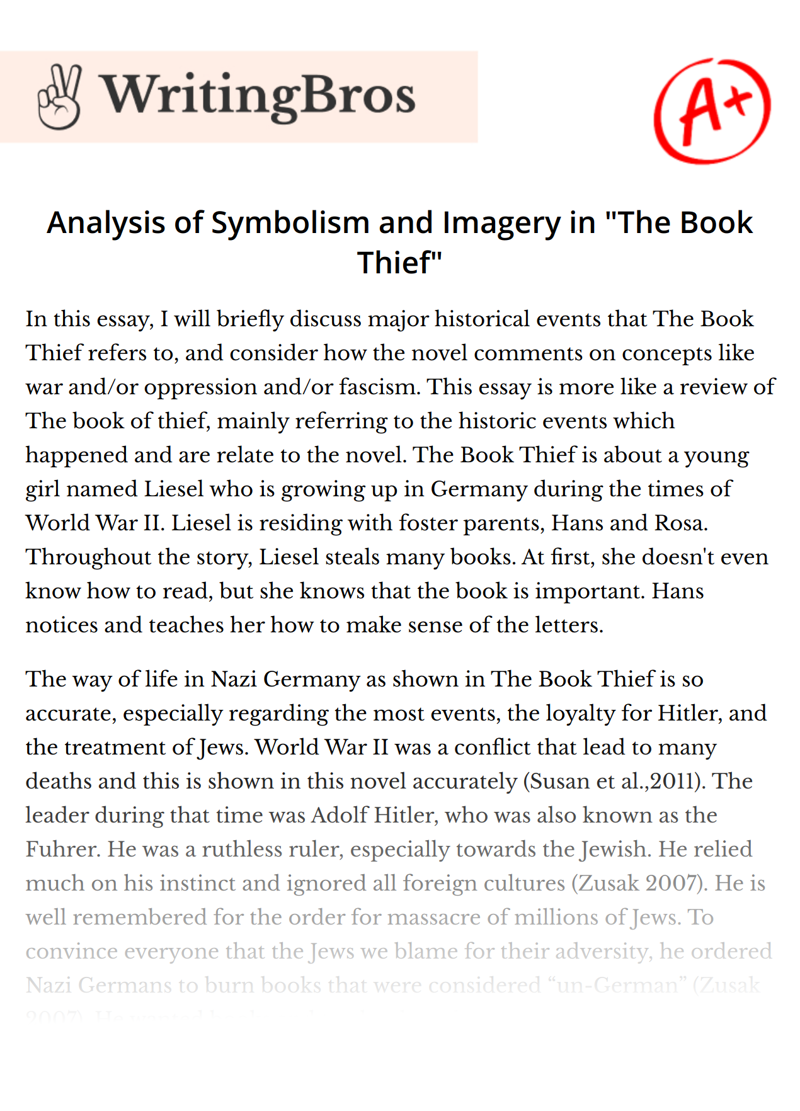Analysis of Symbolism and Imagery in "The Book Thief"

In this essay, I will briefly discuss major historical events that The Book Thief refers to, and consider how the novel comments on concepts like war and/or oppression and/or fascism. This essay is more like a review of The book of thief, mainly referring to the historic events which happened and are relate to the novel. The Book Thief is about a young girl named Liesel who is growing up in Germany during the times of World War II. Liesel is residing with foster parents, Hans and Rosa. Throughout the story, Liesel steals many books. At first, she doesn't even know how to read, but she knows that the book is important. Hans notices and teaches her how to make sense of the letters.
The way of life in Nazi Germany as shown in The Book Thief is so accurate, especially regarding the most events, the loyalty for Hitler, and the treatment of Jews. World War II was a conflict that lead to many deaths and this is shown in this novel accurately (Susan et al.,2011). The leader during that time was Adolf Hitler, who was also known as the Fuhrer. He was a ruthless ruler, especially towards the Jewish. He relied much on his instinct and ignored all foreign cultures (Zusak 2007). He is well remembered for the order for massacre of millions of Jews. To convince everyone that the Jews we blame for their adversity, he ordered Nazi Germans to burn books that were considered “un-German” (Zusak 2007). He wanted books and textbooks to be rewritten to portray that Nazis were good.
In the 1930s and 1940s, the German people were not necessarily intent on murdering millions of Jews and others (Susan et al.,2011). Yet Hitler's pure persuasiveness, along with his total control of Germany's police and media, compelled average Germans to go along with the Holocaust (Zusak 2007). The Book Thief emphasizes both the danger of words and their potential redemptive value. One of the historic events in the novel is the book burnings, Book burnings were part of the reign of Adolf Hitler (Cranny et al., 2001). The book burning represented the power that the Nazis had and how they dealt with ideas that were contradictory to the ideals of Hitler (Cranny et al., 2001). Hans and Liesel attended one of Hitler's public speeches. Liezel sees one of his infamous, or dishonourable, book burning. Realizing Hitler is behind the sufferings, and motivated by her love of literature, Liesel steals the second book in her life from the pile before it burns. Ilsa Hermann, a local, wealthy woman, witnesses Liesel stealing the book and she later invites her to visit her personal library so that she can get to do what she loves the most which is reading. Liezel’s friend, the Jewish refugee Max Vandenburg, hides the map and key to a safe house in a copy of Mein Kampf. Later, Max rips out pages from the book, washes them in white paint, and draws on them a story that is entirely different from the virulent anti-Jew material that Hitler originally wrote (Cranny et al., 2001). The Book Thief illustrates that just as words can make human beings to commit horrific atrocities, words can counteract this evil. Words can forge a remarkable friendship between a hidden Jew and a German girl, words can defy the Nazis when Hitler's propaganda is erased, and beauty and kindness are planted on his pages. (Cranny et al., 2001)
Another historic event which the novel refers to is the Nazi Death Marches, where the Jews were marched through German cities on their way to Nazi concentration camps. During these marches, the Nazi's shot any prisoners who collapsed or couldn't keep pace with the march.
One of these Historic events is Air raids on Germany, On Himmel Street, sirens are heard and everyone runs to the nearest bomb shelter. They stay there until they hear the sirens signalling that it is safe to come out. One night there is an accidental bombing and the sirens don't go off in time. Everyone on Himmel Street dies except for Liesel, who was writing in her basement.
The book thief is a wonderful work by Markus Zusak which follows the story of one young girl and her search for home, family and belonging. Set in National Socialist Germany, this is a small story that pulls at the heart. Her mother’s communist leanings in Nazi Germany brings her to the foster care system on the eve of World War II. Nevertheless, wherever this young heroine goes, she shown a trail transforming the lives of countless people. A story of adoption and a demonstration of Christian values, the book thief is a compelling novel that portrays what love looks like in the middle of extraordinary hardship
Cite this Essay
To export a reference to this article please select a referencing style below

